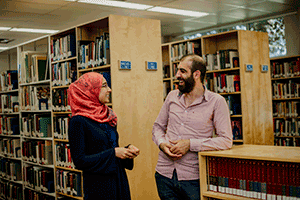Ready to learn more?
Get all the details straight to your inbox!

The Luther Library has over 24,000 items in its collection, 5,000 books checked out per year, and 7,000 students who come through its door per month.

Luther College is a great choice for high school to university transition. Enjoy all the benefits of a larger campus, without feeling lost in the crowd. Our community is full of caring mentors and peers to ensure a positive student experience.

Smaller class sizes at Luther College means more individualized attention and better connections with your professors, classmates, and academic advisors.

To enrol as a Luther College student, simply fill out the University of Regina application form and select Luther as your campus of choice.

The priority deadline for academic application is March 15. To book a personalized enrolment counselling appointment, contact our Recruitment Office at 1-306-206-2117.

Wondering where to live? Our student residence, The Student Village at Luther College, is considered a great choice for first-year student accommodation. Individual private rooms mean you can stick to your own schedule and you never have to deal with roommate hassles.

Eating better means studying better. The Luther Cafeteria offers fresh, healthy, nutritious meals seven days a week with a self-serve “all-you-care-to-eat” concept students prefer.

Free enrolment counselling support and invaluable one-on-one academic advising are available for all programs at Luther College.
Get all the details straight to your inbox!
In this issue of Impetus, we are pleased to highlight the efforts of students with a sample of the excellent scholarly work produced by students enrolled through Luther College and those taking courses at Luther.
One of the courses taught at Luther College covers the history of the European witch hunts. This course is always filled within the first few days of registration. What is it about the topic that continues to hold the interest of scholars, history students and the general public? It is jarring to our sensibilities to learn that between 1500 and 1700, approximately fifty thousand individuals, most of whom were women, were put to death for a crime that, from our perspective, they could not possibly have committed. Historians have spent decades working to explain why the witch hunts occurred. Most would argue that there was no single causal factor, but that the witch hunts resulted from the conjuncture of simultaneous changes in the religious, social, political and judicial climate of Europe. The witch hunts occurred during one of the most tumultuous eras in European history – the era of the Renaissance, the Reformation and the Scientific Revolution. During this period, the rising population of Western Europe entered a period of subsistence crisis resulting in poverty, famine and social disruption. Under such pressures, village solidarity began to erode and neighbours felt increasingly hostile towards those less fortunate. Medical knowledge was rudimentary and even physicians explained illness by recourse to supernatural causes. In such a context, women were particularly vulnerable, as they were involved in the difficult tasks of birthing babies, caring for infants and children, and feeding their families. The witch hunts were the most violent expression of the multiple stresses that confronted the people of Europe five hundred years ago.
The student papers presented hereare a good example of the types of research and variety of topics in the history of the witch hunts. In his paper, “Magic and the Common People of Early Modern Europe,” Ian Temple examines the ambiguities around the concept of magic and shows how such ambiguities set the stage for witchcraft accusations. In their papers, Erin Hillis and Shana Hay both look at how the witch hunts unfolded in England. The English witch trials were rarer and milder than those that took place on the continent. That said, England experienced a witch panic due to the efforts of the professional “witchfinder” Matthew Hopkins. In her paper, “The Unique Concept of the Witch and the Witch Trials in Early Modern Europe,” Hillis argues that Hopkins’ activities were an anomaly, while in “The Historical Significance of Matthew Hopkins,” Hay suggests that they were the culmination of an increasing fear of witches in England. Finally, in his paper entitled “Negligence and Gullibility: An Explanation of the Salem Witch Hunts of 1692,” Peter Steele looks at one of the last, and most famous, of the witch panics. Steele shows how flaws in the legal system led to the conviction and execution of nineteen witches in New England. Taken together, these four student papers suggest something of the range of issues that historians confront and that history students explore in their scholarly efforts.
While the witch hunts ended centuries ago, at times they can appear uncomfortably familiar. Many of the convictions for witchcraft rested upon testimony that had been extracted under torture, and a visit to museums around Europe provides a glimpse at the elaborate instruments of torture used at that time. One of the most important factors in the decline of witchcraft convictions in the seventeenth century was that lawyers and judges began to question the validity of testimony extracted through torture. Regardless, torture continues to be used around the world, as events in recent years have revealed.
Even when torture was not applied, the use of intimidation, circumstantial evidence, leading questions and the testimony of young children meant that witch panics could quickly grip an entire community. Historians find direct parallels between the early modern witch panics and much more recent panics, such as those around satanic sex abuse scandals, which relied on the same questionable legal practices. Fear and panic can lead to irrationality in any period, past and present.
Even as we struggle to make sense of the atrocities of the past, the century most of us were born and grew up in has been witness to atrocities that even the most ardent witch hunters or inquisitors could not have imagined. The twentieth century gave us mechanised mass slaughter, the first truly global wars, and perfected the idea of genocide, even among citizens of the nation launching the genocide. While historical documents can provide important perspectives that can help us understand the contexts of such atrocities, it is the domain of literature to get inside the skins of the people who witnessed these horrors and to articulate what legal documents, news reports, and military dispatches cannot do.
Hannah Sauchyn’s paper, “A New Bearing Witness to Atrocity: Robert Hass’s Time and Materials and Anne Simpson’s Light Falls through You,” examines the work of two contemporary poets who study human relationships against the backdrop of the atrocities in Rwanda, Korea, Bosnia, and Iraq. While many poets have attempted to give voice to atrocity, Hass and Simpson are unusual in that they are writing from the position of North American non-combatants witnessing global horrors from the comfort and security of the United States and Canada, respectively. Sauchyn points out that, while these poets do not give us an “authentic” voice of the victims of horror, they nevertheless offer an important perspective: global atrocities affect all of us, even those who are not directly victimised. A poetics of “witness” can also include those who see only from their newspapers or televisions. These events form our experience of reality, and even affect the way we interact with people directly in our field of vision. In fact, Hass’ “conscience,” which one critic complains won’t “shut up” in his poems, colours his view of all relationships, from his lover to an émigré waiter.
The challenge Hass and Simpson offer is to make sense of the beauty of the world, especially the peaceful, prosperous world they themselves inhabit, while yet remaining conscious of the brutality and destruction of war. Moreover, Hass and Simpson also challenge us to find an aesthetic dimension in these images of atrocity, especially since we, like they, experience them only as images, not as direct experience. Whether it is the astonishing ferocity of the 17th-century witch hunt, or the devastating carnage of 20th-century genocide, art challenges us to witness and to make sense of the reality of atrocities that humans visit upon each other.
As always, the Impetus editorial board encourages readers to provide feedback on these or any other Impetus pieces at impetus@luthercollege.edu. Members of the Luther community may also submit work for a future issue of Impetus – please read the submission guidelines for additional information.
Best wishes from the Impetus editorial board:
Jennifer Arends (alumni relations, development & communications)
Dr Noel Chevalier (English), guest contributor
Dr Yvonne Petry (history)
Dr William Stahl (sociology)